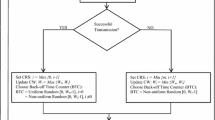Abstract
This paper evaluates the effects of the Extended Non-Overlapping Binary Exponential Backoff (ENO-BEB) algorithm over IEEE 802.15.4 by building its performance models based on a 2-dimensional Markov chain. This algorithm differs from the previously proposed Non-Overlapping Binary Exponential Backoff (NO-BEB) algorithm for IEEE 802.11, where the next backoff range is fixed as the second half of the conventional exponentially enlarged range. The ENO-BEB algorithm maps the next backoff range to the last 1/2j-th subrange of the conventional range where j is an integer standing for the number of consecutive channel capture failures. To measure its impacts of the degree of separation between two backoff ranges at two adjacent backoff stages, we generalize the conventional IEEE 802.15.4 Markov chain model by including the behavior of the ENO-BEB algorithm. The analytical performance model predicts that the ENO-BEB technique achieves better throughput for larger j, for example, up to 113 % and 21 % than the conventional BEB and NO-BEB algorithm, respectively when j and the total number of nodes are 3 and 60. Simulations confirm these numerical results with a 7 % difference.






Similar content being viewed by others
References
Wireless Medium Access Control (MAC) and Physical Layer (PHY) specifications for Low-Rate Wireless Personal Area Networks (LR-WPANs). IEEE Standard 802.15.4-2003.
Wireless Medium Access Control (MAC) and Physical Layer (PHY) specifications for Low-Rate Wireless Personal Area Networks (LR-WPANs). IEEE Standard 802.15.4-2006.
IEEE 802.11 WG, Part 11: wireless LAN Medium Access Control (MAC) and Physical Layer (PHY) specification (1999).
Pollin, S., Ergen, M., Ergen, S. C., Bougard, B., der Perre, L. V., Moerman, I., Bahai, A., Varaiya, P., & Catthoor, F. (2008/2009). Performance analysis of slotted carrier sense IEEE 802.15.4 medium access layer. IEEE Transactions on Wireless Communications, 7(9), 3359–3371.
Bharghavan, V., Demers, A., Shenker, S., & Zhang, L. (1994). MACAW: a media access protocol for wireless LANs. In Proc. of the conference on communications architectures, protocols and applications (pp. 212–225). New York: ACM.
Song, N. O., Kwak, B. J., Song, J., & Miller, L. E. (2003). Enhancement of IEEE 802.11 distributed coordination function with exponential increase exponential decrease backoff algorithm. In The IEEE vehicular technology conference, spring 2003, New Orleans, April 2003.
Kuo, W., & Jay Kuo, C.-C. (2003). Enhanced backoff scheme in CSMA/CA for IEEE 802.11. In The IEEE vehicular technology conference, fall 2003, Orlando, October 2003.
Deng, J., Varshney, P. K., & Haas, Z. J. (2004). A new backoff algorithm for the IEEE 802.11 distributed coordination function. In Proc. of communication networks and distributed systems modeling and simulations (CNDS ’04), January 2004.
Rama Krishna, C., Chakrabarti, S., & Datta, D. (2004). A modified backoff algorithm for CSMA-based MAC protocol in mobile ad hoc networks. In Proc. of the international conference on computers and devices for communication 2004 (CODEC-04), Institute of Radio Physics and Electronics, Kolkata, India, 1–3 January 2004.
Minooei, H., & Nojumi, H. (2007). Performance evaluation of a new backoff method for IEEE 802.11. Computer Communications, 30(18), 3698–3704.
The ns-2 simulator. http://www.isi.edu/nsnam/ns/.
Chen, Z., Lin, C., Wen, H., & Yin, H. (2007). An analytical model for evaluating IEEE 802.15.4 CSMA/CA protocol in low-rate wireless application. In Proc. of AINAW’07 (pp. 899–904).
Park, T., Kim, T., Choi, J., Choi, S., & Kwon, W. (2005). Throughput and energy consumption analysis of IEEE 802.15.4 slotted CSMA/CA. Electronics Letters, 41(18), 1017–1019.
Shin, Y.-S., Hyun, G.-W., Ahn, J.-S., Kim, H.-C., & Lee, K.-W. (2009). An analytical model for LR-WPAN performance in the presence of hidden nodes. KIPS Transactions, Part C, 16(1), 133–142.
Bianchi, G. (2000). Performance analysis of the IEEE 802.11 distributed coordination function. IEEE Journal on Selected Areas in Communications, 18(3), 535–547.
Park, C. G., Han, D. H., & Ahn, S. J. (2006). Performance analysis of MAC layer protocols in the IEEE 802.11 wireless LAN. Telecommunications Systems, 33(1–3), 233–253.
Author information
Authors and Affiliations
Corresponding author
Additional information
This research was supported by Basic Science Research Program through the National Research Foundation of Korea (NRF) funded by the Ministry of Education, Science and Technology (No. NRF-2012R1A1A2020051).
This work was supported by Dongguk University Research Fund.
Rights and permissions
About this article
Cite this article
Lee, SY., Shin, YS., Lee, KW. et al. Performance analysis of Extended Non-Overlapping Binary Exponential Backoff algorithm over IEEE 802.15.4. Telecommun Syst 55, 39–46 (2014). https://doi.org/10.1007/s11235-013-9749-3
Published:
Issue Date:
DOI: https://doi.org/10.1007/s11235-013-9749-3




